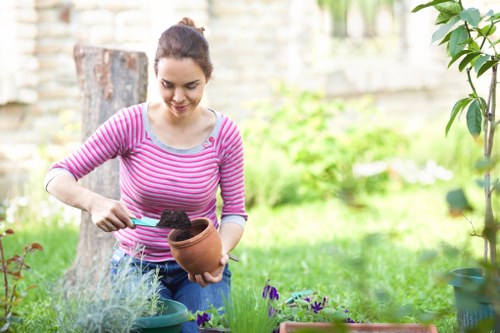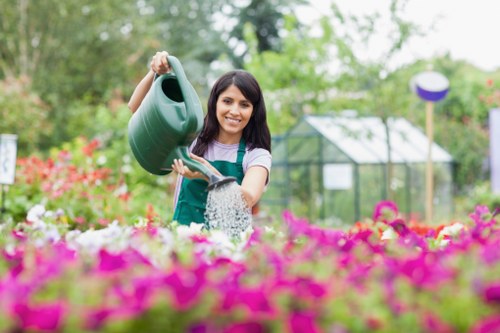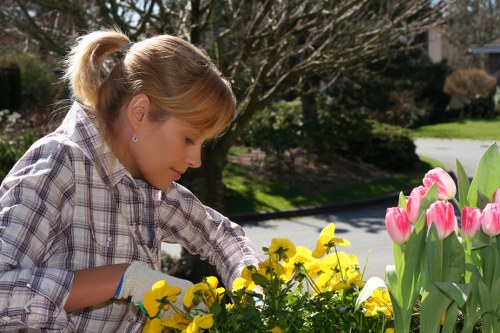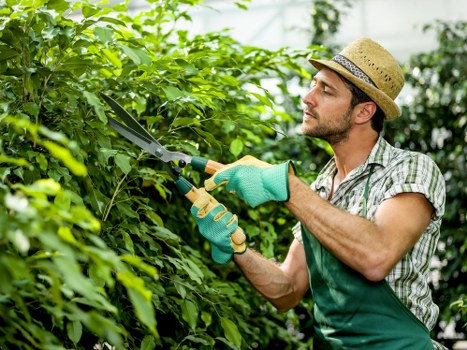Comprehensive Garden Maintenance in Shoreditch

Maintaining a beautiful garden in Shoreditch requires a combination of knowledge, dedication, and the right tools. Whether you’re a seasoned gardener or a beginner, understanding the unique aspects of garden maintenance in this vibrant London neighborhood can transform your outdoor space into a lush, inviting retreat.
Shoreditch, known for its eclectic mix of modern and historic architecture, offers a unique backdrop for gardening enthusiasts. The area's urban setting presents both opportunities and challenges for garden maintenance, from limited space to diverse plant life.
In this guide, we will explore essential tips and strategies for effective garden maintenance in Shoreditch, ensuring your garden thrives year-round.

Understanding the Shoreditch Climate
Shoreditch experiences a temperate maritime climate, characterized by mild winters and cool summers. This climate is generally favorable for a wide variety of plants, but it also means gardeners must be prepared for occasional frost and unpredictable weather patterns.
**Key Considerations for Climate-Resilient Gardening:
- Frost Protection: Use mulch and frost covers to protect sensitive plants during unexpected cold snaps.
- Soil Management: Well-draining soil is crucial to prevent waterlogging during heavy rains.
- Plant Selection: Choose native and hardy plant species that can withstand local climate conditions.
By understanding and adapting to Shoreditch's climate, you can create a resilient garden that flourishes throughout the year.

Essential Garden Maintenance Tasks
Regular maintenance is the cornerstone of a healthy garden. In Shoreditch, where space may be limited, staying on top of these tasks is even more critical to ensure your garden remains vibrant and manageable.
1. Pruning and Trimming
Pruning helps maintain plant health by removing dead or diseased branches, promoting air circulation, and encouraging new growth. Regular trimming also keeps your garden looking neat and well-kept.
2. Weeding
Weeds compete with your plants for nutrients and water. Consistent weeding prevents unwanted plants from taking over your garden, allowing your chosen flora to thrive.
3. Watering
Proper watering is essential, especially in an urban environment where access to natural water sources may be limited. Invest in a reliable irrigation system to ensure your plants receive adequate moisture.
Advanced Watering Techniques
Consider implementing drip irrigation or soaker hoses to deliver water directly to the plant roots, reducing water waste and promoting efficient hydration.
_Regular monitoring_ of soil moisture levels can help you adjust your watering schedule based on seasonal changes and plant needs.
Scheduling is Key
Create a maintenance schedule to track tasks such as pruning, weeding, and watering, ensuring nothing is overlooked.

Choosing the Right Plants for Shoreditch Gardens
Selecting plants that are well-suited to Shoreditch’s climate and urban environment is crucial for a thriving garden. Here are some recommendations:
- Perennials: Offer longevity and require less maintenance once established.
- Succulents: Ideal for low-water gardens and limited spaces.
- Climbing Plants: Utilize vertical space effectively, adding greenery without taking up ground space.
- Herbs and Edibles: Combine aesthetic appeal with practicality, allowing you to grow your own herbs and vegetables.
Consider incorporating a mix of these plants to create a diverse and resilient garden ecosystem.

Soil Health and Fertilization
Healthy soil is the foundation of a robust garden. In Shoreditch, where soil quality can vary, taking steps to improve and maintain soil health is essential.
Soil Testing
Conducting a soil test provides valuable information about pH levels, nutrient content, and soil composition. This data helps you make informed decisions about amendments and fertilizers.
Amending the Soil
Adding organic matter such as compost enhances soil structure, improves drainage, and increases nutrient availability. Regularly incorporating compost can lead to more vigorous plant growth.
Natural Fertilizers
Opt for natural fertilizers to avoid chemical buildup in the soil. Options like bone meal, fish emulsion, and seaweed extract provide essential nutrients without harming the environment.
Mulching: Applying a layer of mulch helps retain moisture, suppress weeds, and regulate soil temperature.

Integrated Pest Management
Protecting your garden from pests is a continuous challenge. Integrated Pest Management (IPM) offers a proactive approach to controlling pests while minimizing environmental impact.
Monitoring and Identification
Regularly inspect your plants for signs of pests or diseases. Early detection allows for prompt and effective treatment.
Biological Controls
Introduce beneficial insects such as ladybugs and predatory beetles to naturally control pest populations.
- Ladybugs feed on aphids and other soft-bodied pests.
- Praying Mantises are generalist predators that can help keep pest numbers in check.
Cultural Practices
Implementing good gardening practices, such as crop rotation and proper spacing, reduces the likelihood of pest infestations.
Natural Remedies
Use neem oil, insecticidal soaps, and other organic treatments to manage pests without harming beneficial insects or the environment.

Seasonal Garden Maintenance
Adapting your maintenance routine to the changing seasons ensures your garden remains healthy and vibrant throughout the year.
Spring
Spring is the perfect time for planting new flowers and vegetables, pruning overgrown shrubs, and preparing your garden beds for the growing season.
Summer
Focus on regular watering, deadheading spent blooms, and monitoring for pests and diseases during the hot summer months.
Autumn
Prepare your garden for winter by clearing fallen leaves, planting autumn-blooming flowers, and adding compost to enrich the soil.
Winter
While many plants are dormant, winter is an ideal time to plan for the upcoming year, perform equipment maintenance, and protect sensitive plants from frost.
Pro Tip: Use seasonal changes to experiment with new plant varieties and garden designs.

Efficient Garden Tools and Equipment
Having the right tools can significantly enhance your garden maintenance efforts. Invest in quality equipment to make tasks easier and more effective.
- Pruning Shears: Essential for maintaining plant shape and health.
- Garden Forks: Useful for turning soil and aerating garden beds.
- Watering Systems: Drip irrigation systems save water and ensure consistent plant hydration.
- Compost Bins: Efficiently recycle garden waste into valuable compost.
Regular maintenance of your tools ensures longevity and optimal performance, making your garden care routine more efficient.

Maximizing Limited Space in Urban Gardens
Shoreditch’s urban environment often means limited garden space. However, with creative solutions, even small areas can become lush and functional.
Vertical Gardening
Utilize vertical space by installing trellises, wall planters, and hanging baskets. This approach not only saves space but also adds visual interest to your garden.
Container Gardening
Growing plants in containers is an excellent way to manage limited space. Choose a variety of pots and planters to create a dynamic and flexible garden layout.
Multi-Functional Plantings
Select plants that offer multiple benefits, such as producing flowers, providing shade, or serving as edible crops. This maximizes the utility of each plant in your garden.
Smart Plant Placement
Arrange plants strategically to optimize space and sunlight exposure, ensuring each plant thrives without overcrowding.
Remember: Regular pruning and careful planning are key to maintaining a healthy and organized urban garden.

Sustainable Gardening Practices
Embracing sustainability in your garden not only benefits the environment but also enhances the health and longevity of your plants.
Water Conservation
Implementing water-saving techniques, such as rainwater harvesting and mulching, reduces water usage and promotes eco-friendly gardening.
Organic Gardening
Avoid synthetic chemicals by using organic fertilizers and natural pest control methods. This approach supports beneficial insects and maintains soil health.
Composting
Recycling kitchen and garden waste into compost enriches the soil with essential nutrients, decreases landfill waste, and fosters a healthier garden ecosystem.
Reducing Waste
Minimize garden waste by repurposing materials, using biodegradable pots, and recycling plant debris.
Eco-Friendly Tip: Choose native plants that require less water and are more resistant to local pests and diseases.

Professional Garden Maintenance Services in Shoreditch
While DIY garden maintenance is rewarding, professional services can offer expertise and efficiency, especially for larger or more complex gardens.
Benefits of Hiring Professionals
Experienced garden maintenance professionals bring specialized knowledge, access to high-quality tools, and the ability to handle challenging tasks that may be beyond the scope of amateur gardeners.
Services Offered
- Comprehensive garden planning and design
- Regular maintenance, including pruning, weeding, and fertilizing
- Irrigation system installation and maintenance
- Seasonal clean-ups and plant health assessments
Choosing the Right Service
Look for services that understand the unique needs of Shoreditch gardens, offer customizable packages, and have positive reviews from local clients.
Investing in professional garden maintenance can save you time and ensure your garden remains in optimal condition year-round.

DIY Garden Maintenance Tips
If you prefer a hands-on approach, here are some practical tips to keep your Shoreditch garden thriving:
Create a Maintenance Schedule
Organize your tasks by creating a calendar that outlines when to water, prune, fertilize, and perform other essential activities. This ensures consistency and prevents tasks from being overlooked.
Proper Tool Maintenance
Keep your gardening tools clean and sharp. Regular maintenance extends their lifespan and improves their efficiency.
Healthy Plant Selection
Choose disease-resistant and hardy plant varieties to reduce the risk of infestations and minimize maintenance efforts.
Mulching Techniques
Apply a layer of organic mulch to retain soil moisture, suppress weeds, and regulate soil temperature. This simple step can significantly improve plant health.
_Stay proactive_ in monitoring your garden’s health, addressing issues promptly to keep your plants flourishing.

Enhancing Garden Aesthetics
Aesthetics play a significant role in garden maintenance. A visually appealing garden not only boosts your property’s value but also provides a serene environment for relaxation.
Color Coordination
Select plants that offer a cohesive color palette, creating a harmonious and attractive outdoor space.
Garden Structures
Incorporate elements like pergolas, garden benches, and pathway lighting to add structure and functionality to your garden.
Seasonal Blooms
Plan for a succession of blooms throughout the year to ensure your garden remains vibrant in every season.
Creative Plant Combinations
Experiment with different plant textures and heights to add depth and interest to your garden design.
Visual Appeal Tip: Use containers and raised beds to introduce varied heights and focal points within your garden.

Lighting and Garden Maintenance
Proper lighting enhances both the functionality and beauty of your garden. It allows you to enjoy your outdoor space even after dark and can highlight key features.
Types of Garden Lighting
- Path Lights: Illuminate walkways for safety and convenience.
- Spotlights: Highlight specific plants or garden structures.
- Ambient Lighting: Create a warm and inviting atmosphere with string lights or lanterns.
Energy-Efficient Options
Opt for LED lights or solar-powered fixtures to reduce energy consumption and minimize your garden’s environmental footprint.
Installation Tips
Plan your lighting layout carefully to ensure even coverage and avoid over-illumination. Consider professional installation for more complex lighting setups.
Enhancing your garden with thoughtful lighting can extend your outdoor enjoyment and add a magical touch to your nighttime garden scenery.

Maintaining Garden Furniture and Accessories
Your garden furniture and accessories contribute to the overall appeal and functionality of your outdoor space. Proper maintenance ensures longevity and sustained beauty.
Cleaning and Protection
Regularly clean your garden furniture to prevent dirt buildup and apply protective finishes to shield against weather damage.
Storage Solutions
Store cushions, umbrellas, and other accessories in dry, sheltered areas during adverse weather or off-seasons to extend their lifespan.
Upgrading and Refreshing
Periodically update your garden accessories to keep the space fresh and in line with current design trends.
Eco-Friendly Practices
Choose sustainable materials and repurpose old furniture to minimize waste and support environmentally friendly gardening practices.
Maintenance Tip: Inspect your garden furniture regularly for signs of wear and address any issues promptly to maintain a pristine outdoor environment.

Final Thoughts on Garden Maintenance in Shoreditch
Maintaining a garden in Shoreditch requires a blend of careful planning, regular upkeep, and a deep understanding of the local environment. By implementing the strategies outlined in this guide, you can cultivate a thriving garden that enhances your living space and provides a haven of natural beauty in the heart of the city.
Whether you choose to undertake garden maintenance yourself or enlist the help of professional services, the key to success lies in consistency, attention to detail, and a passion for nurturing your green space.
Ready to transform your garden? Contact us today to discover how our expert garden maintenance services can help you achieve the outdoor sanctuary you’ve always dreamed of.

